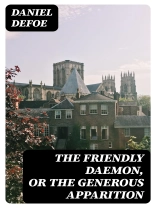In ‘The Friendly Daemon, or the Generous Apparition, ‘ Daniel Defoe explores the intersection of the supernatural and the human experience through a narrative steeped in allegory and moral inquiry. This novella unfolds the story of a benevolent spirit who intervenes in the lives of morally ambiguous characters, challenging societal norms and expectations. Defoe’s masterful prose is marked by a blend of the metaphysical and the mundane, which invites readers to consider the nuances of human morality against the backdrop of divine providence and supernatural influence prominent in early 18th-century literature, reflecting the period’s burgeoning interest in individualism and spiritual introspection. Daniel Defoe, best known for his pioneering work in the novel form, drew upon his own experiences as a tradesman and a controversial figure in political discourse. His varied career as a merchant, journalist, and pamphleteer informs the depth of character and moral complexity in this work. The themes of redemption and moral choice reflect Defoe’s lifelong engagement with the concepts of virtue and the human condition, likely influenced by the tumultuous socio-political landscape of his time. This thought-provoking text is a must-read for those interested in the evolution of the novel and the exploration of moral philosophy through the lens of early modern literature. Defoe’s unique perspective makes this an engaging read that encourages deep reflection on the nature of good and evil, making it a valuable addition to both literary studies and philosophical discourse.
Про автора
Daniel Defoe (c. 1660 – 1731) was an English writer, journalist, and spy, now most famous for his novel ‘Robinson Crusoe’ (1719). Born as the son of James Foe, a butcher from London, Defoe later added ‘De’ to his surname to sound more gentlemanly. He was a prolific writer and a keen observer of society, which is reflected in his work. Defoe’s ‘The Friendly Daemon, or the Generous Apparition’ is a lesser-known work that, like many of his publications, takes on a narrative style close to reportage, with nuanced exploration of the human psyche and social relationships. His literary style often combined realism with didacticism, and he is considered an early proponent of the English novel. Defoe’s other notable works include ‘Moll Flanders’ (1722) and ‘A Journal of the Plague Year’ (1722), which exhibit the same narrative verisimilitude as his famous marooned castaway. Despite the diversity in themes, Defoe’s novels and pamphlets are commonly underscored by a detailed examination of contemporary morals, economics, and politics. His writings have been scrutinized by literary scholars and historians alike, decoding the socio-economic tapestries of early 18th-century Britain.












